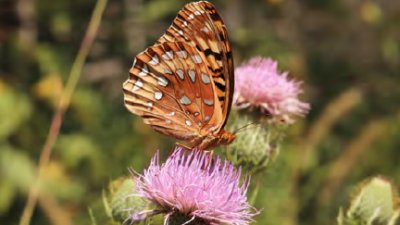AgEBB-MU CAFNR Extension
Green Horizons
Volume 24, Number 3
Fall 2020
Wait! Don't Kill that Thistle!
Tim Smith, adapted from his "Missouri's Thistles" Missouri Prairie Journal article
Blooming now in prairies, along roadsides, disturbed fields, and pastures are tall, prickly plants that are often all referred to as "thistles." While there are several aggressively spreading, nonnative thistles that do cause problems in Missouri and surrounding states, there are also native thistles that are not invasive and are bene cial components of native habitats and plantings.
 |
This article on thistles from the Missouri Prairie Journal provides detailed drawings and a key to help you identify thistles. An easy rule of thumb to follow, however, is to check the underside of the leaves. If the underside is whitish, the thistle is native; if the underside is green, it is non-native*, and treatment is recommended so the plant doesn't set seed and spread. If spot treatment is not possible, you can cut down the flower stalks to avoid seed development.
Non-native "thistles"include spotted knapweed (Centaurea stoebe ssp. micranthus), musk thistle (Carduus nutans), Canada thistle (Cirsium arvense), bull thistle (Cirsium vulgare), and Scotch thistle (Onopordum acanthium ssp. acanthium), with the first two species being the most widespread in Missouri.
Native species include field thistle (Cirsium discolor), which can be abundant in open woodlands or savannas undergoing restoration, and in prairie plantings, but is not likely to persist in high numbers. Another common native species is tall thistle (Cirsium altissimum). A native inhabitant of prairies, it seldom grows in great abundance. In summer, it provides a nectar source for butterflies and later, seeds for visiting goldfinches and other birds. Thistledown, the fine hairs attached to the mature seeds of this and other thistles, are used by a variety of birds and small mammals for lining nests.
*an exception to the "green underside = non native thistle" rule is the native swamp thistle (Cirsium muticum), which in uncommon small wetland areas in the Ozarks called fens. It is native, the underside of its leaves are green, and it is known from only seven counties in Missouri.
 |
